Most leaders intuitively understand what XM Institute has labeled the employee engagement virtuous cycle, which describes a strong link between customer experience (CX) and employee experience (EX). To help operationalize the connection, we’ve further identified four categories of CX and EX alignment. But how do you uncover the specific employee experiences that are most connected to better customer results for your organization?
To explore this analytical linkage, Qualtrics XM Scientists conducted an analysis with five organizations who met two criteria: 1) they were location-based businesses with front-line staff, and 2) they had established CX and EX programs with historical metrics. The analysis was conducted using each organization’s existing data, which fell into the following categories:
- EX Outcomes. These are key performance indicators that organizations track as lag metrics to determine overall employee experiences. Common EX outcome measures are engagement, inclusion, well-being, and intent to stay, which are all highly related to employee and business success.
- EX Drivers. These are critical experiences and perceptions that influence the EX outcome metrics. EX drivers provide critical signals as to where action should be taken to improve employee experience in the organization. They incorporate many aspects of work that are important to employees such as communication, work processes, customer focus, training, and more.
- CX Outcomes. These are metrics an organization tracks as indicators for overall customer experience performance, such as NPS and CSAT. These metrics are highly connected to organizational outcomes, such as revenue, conversion rates, sales targets, and customer retention.
- CX Drivers. These are measures of key customer experiences that influence CX outcomes across a customer’s journey, such as ease of use, customer support team responsiveness, issue resolution time, product reliability, on-time delivery, and more.
Six Pathways for Analyzing the Link Between EX and CX Metrics
To organize the analysis for each organization, we identified a unique combination of six possible pathways for data analysis using bivariate correlations and/or multivariate regression methods.

- EX drivers of EX outcomes. Generates insights into the relationship between particular employee experiences (lead signals) and overall EX outcomes (or KPIs) such as Engagement or Intent to stay. EX driver analysis is typically conducted within an existing EX program to generate targeted action plans to improve overall employee experience. For example, you may find that employees feeling free to share opinions openly without fear of retaliation is highly correlated with overall employee engagement.
- EX drivers of CX outcomes. Identifies the employee experience signals connected to customer experience outcomes, and the strength of these relationships. This pathway provides actionable insight into which employee experiences are driving customer outcomes. For example, you may discover that employees having the training they need to do their job effectively is strongly related to NPS scores.
- EX outcomes related to CX outcomes. Provides initial evidence of the connection between overall employee experience and customer experience outcomes. For example, you can show the strength of the connection between employee engagement and customer satisfaction metrics. To uncover more targeted actionable insights, follow up with Pathway #2 to determine which employee experiences are driving customer outcomes.
- EX drivers related to CX drivers. Delivers insights into which employee experiences are connected to specific customer experiences, and the strength of these relationships. This output can be quite detailed, due to the number of variables. For example, you may discover that customer care employees who are recognized for their hard work are more likely to solve customer problems quickly. For higher impact analysis and connection with business outcomes, combine this with pathway #6.
- EX outcomes related to CX drivers. Determines the strength of the relationship between overall employee experience metrics and specific customer experiences. For example, you may discover that locations with the highest employee engagement also have the highest customer ratings for staff friendliness.
- CX drivers of CX outcomes. Uncovers insights into which elements of the customer experience are driving customer outcomes. This is typically done within a CX program prior to linking EX and CX data but is an important analysis to identify critical signals and generate targeted action plans to improve overall customer experience. For example, looking at the customer journey, ease of product use and satisfaction with customer service interactions are predictors of NPS scores.
Frontline Employee Experiences Linked to CX Outcomes
Across these studies, the connection between EX drivers and CX outcomes (pathway #2) was the most common analysis, conducted by all five organizations. The linkage analysis between EX outcomes and CX drivers (pathway #5) was not conducted by any organizations in this sample. Typically, EX drivers of EX outcomes (pathway #1) and CX drivers of CX outcomes (pathway #6) were already established within the existing programs prior to this analysis, which is an opportunity to go beyond these foundational analyses.
All of the projects uncovered extremely valuable and unique insights for the companies. However, three consistent patterns in which frontline employee experiences are most strongly connected to customer experience outcomes were discovered (which you can see in the graphics below):
- Expressing a connection with the organization’s vision, values, and purpose, or pride in the company’s products and services (the virtuous cycle is alive and well).
- Feeling safe, respected, cared for, and treated equitably.
- Being empowered, enabled, and rewarded for delivering great customer service.
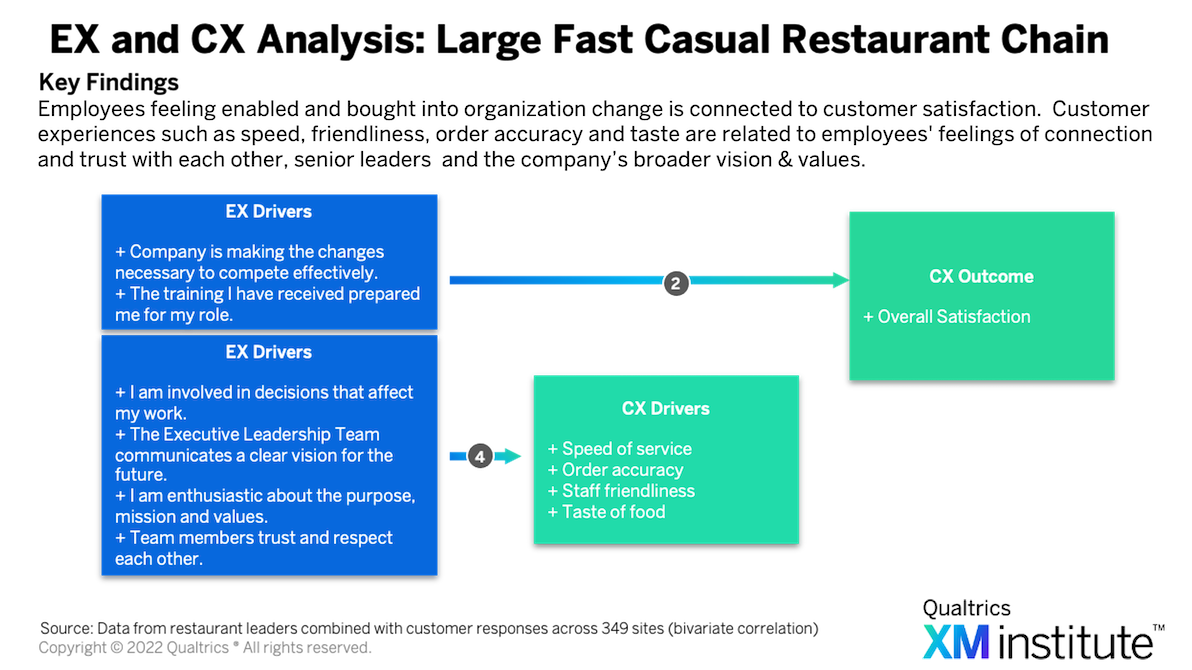
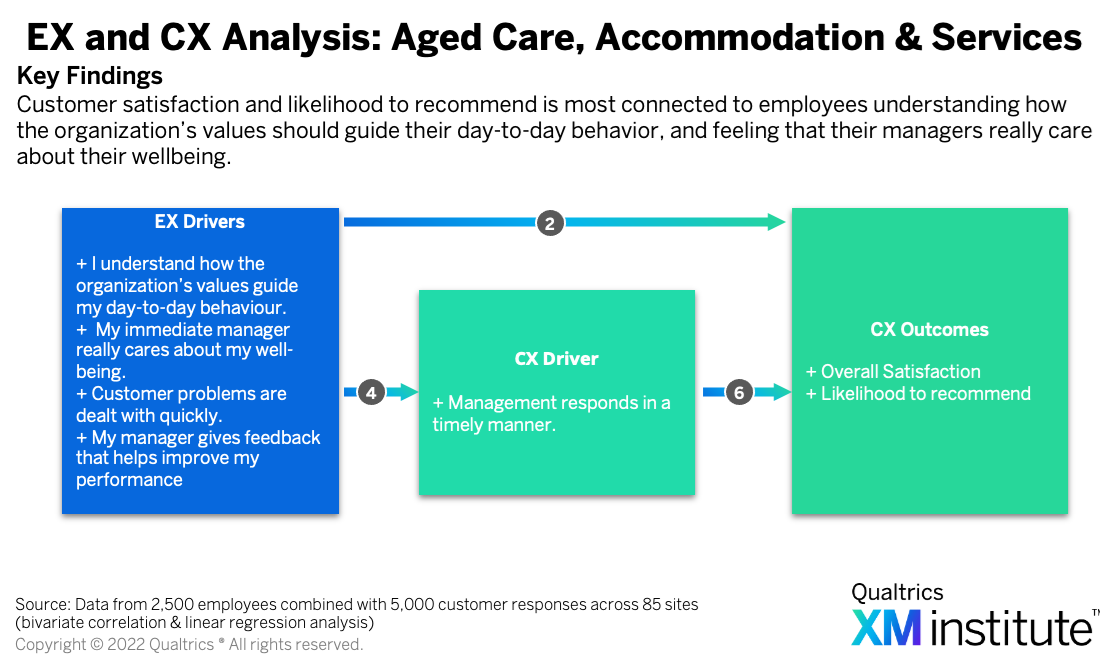
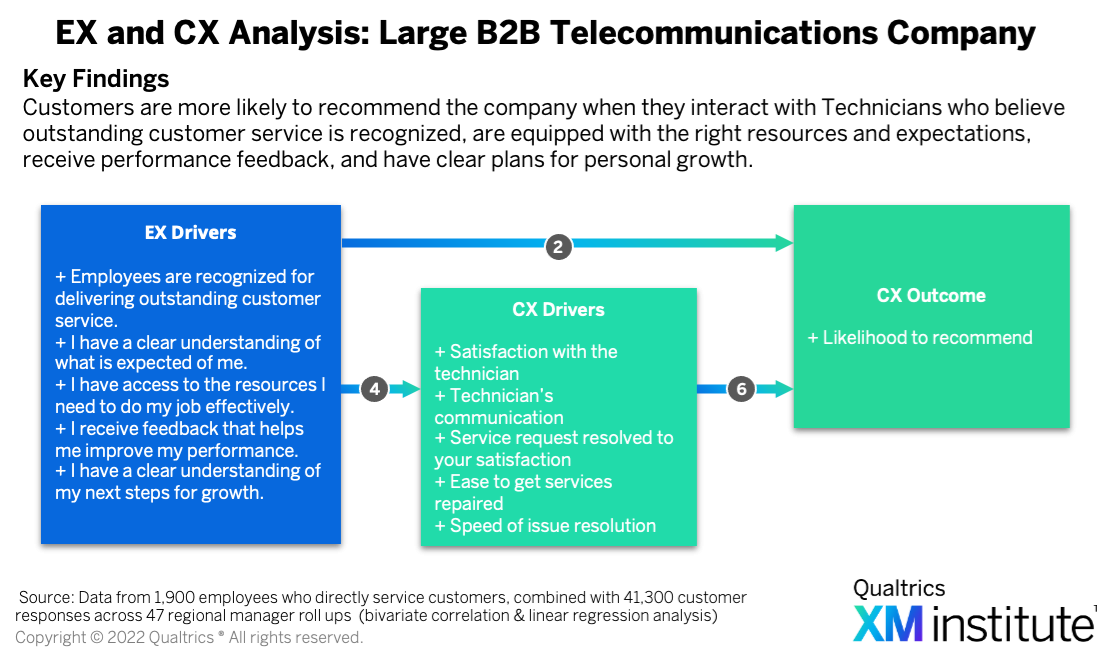
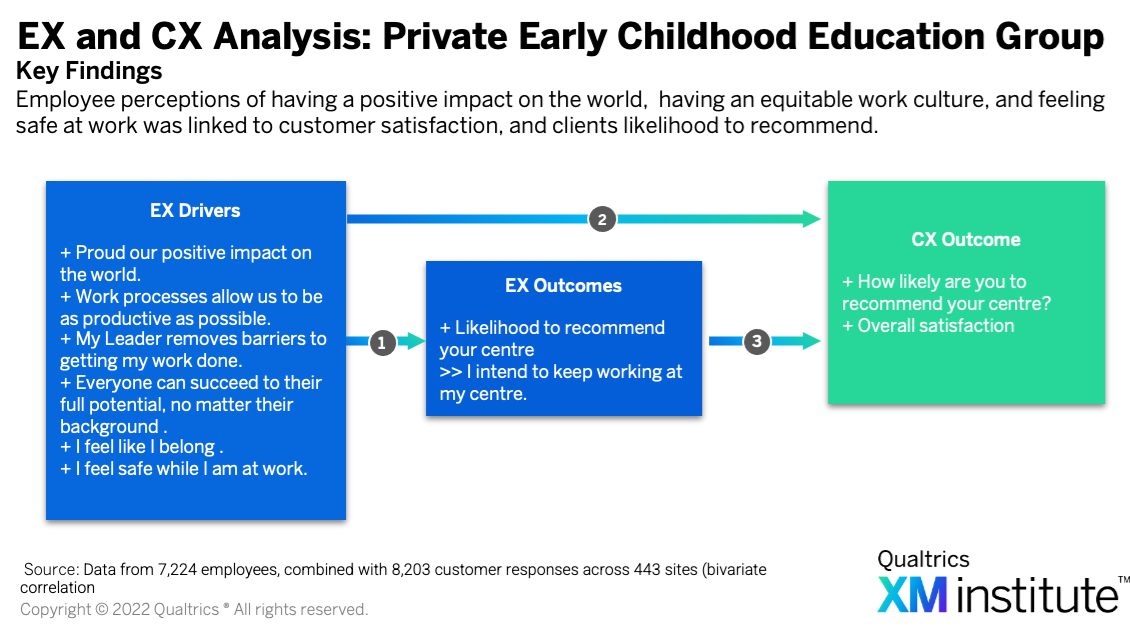
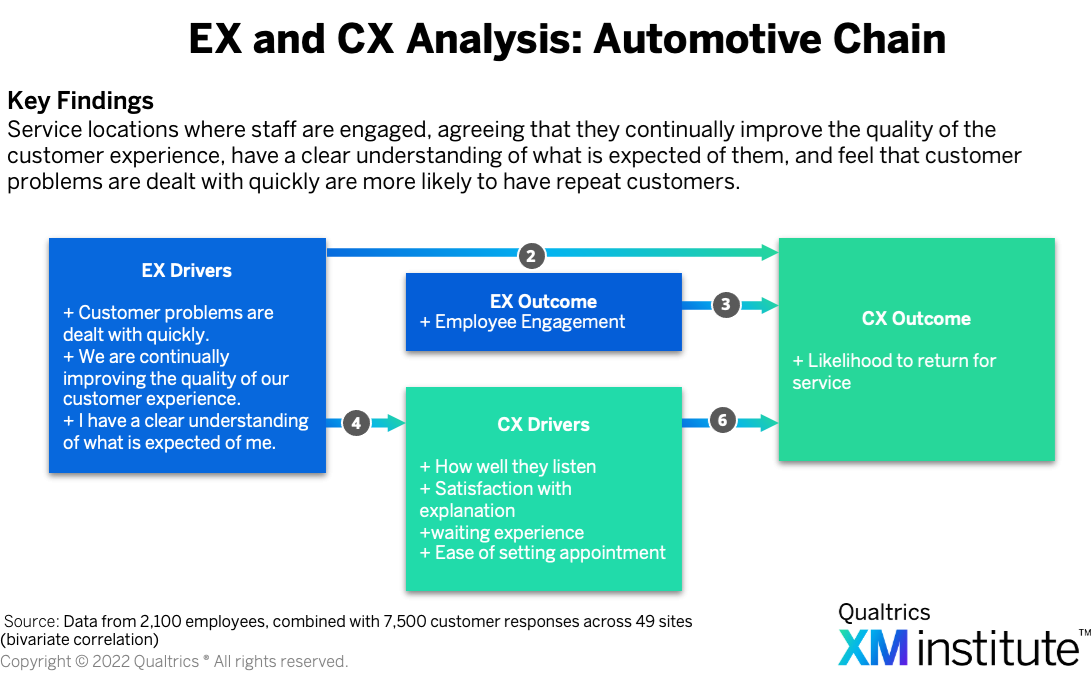
Advice for Analyzing CX and EX Linkages
We asked the XM Professionals who completed the analysis to share their advice on how to successfully extract and deliver impactful insights about the link between EX and CX metrics. Here is what they told us:
- Focus on the metrics that matter. Capture the attention of senior leaders by focusing on the employee experiences that drive the KPIs they care about most. Here’s what one of the XM professionals told us:
“Every one percent that we increase employee engagement, it equates to a 2% increase in customer engagement and a 0.5% increase in our profit after controllables, which are our financial measures. So then when I go to operations or to our executive team and say, ‘hey, we need to invest in this because we can show how to increase the profit of the company while also enhancing the employee and guest experience’, it’s a no-brainer.”
- Identify the EX signals to look out for. Use the insights to clearly articulate which elements of employee experiences are critical for continued organizational performance. This compelling narrative can shift an organization from a reactive mode where employee issues are resolved as they arise, towards a proactive standpoint where leaders focus on the right signals and take action to improve frontline employee experience as a strategic lever. Here’s what one of the XM professionals told us:
“The fun one that I share with everyone is that the higher their favorability about the vision that the ELT sets for the future, the higher our order accuracy score. And people are like, ‘they have nothing to do with each other’…. Think about it…. if I’m excited about our future, the direction we’re going and our vision, I’m probably going to put in more discretionary effort than, if I were just punching in, doing the minimum and punching out.”
- Create a shared EX and CX vision. Continue to converge on a shared XM vision and practices for the organization, where human experiences (and insights that reflect them) are at the heart of your business operations. This builds the momentum for advancing your XM maturity journey, establishing collaboration and shared goals between EX and CX teams, as well as aligning technologies and platforms to underpin these efforts.
- Bring people along the journey with you. One piece of advice that came up a lot was to engage your stakeholders early and often throughout this process. Think more broadly than your existing stakeholders, as they can provide a lot of unexpected value to this process.
“I would probably bring in people who I would have never have imagined as stakeholders into the conversation sooner. People like business intelligence data scientists or external and internal communications or government relations. There has just been so much value from getting perspective from people outside of our normal, EX or CX stakeholder group”
- Start where you are. Begin with a small data set or whatever data you have access to as the basis for developing a proof of concept, and then go from there. The companies that worked with Qualtrics on these studies used these insights to develop a business case to increase investment in these programs.
- Set your current XM program metrics up for this analysis. These XM professionals shared that there were two features of their existing EX and CX programs that they wish they had considered earlier. The first is to resist the temptation to edit the wording of surveys over time and stay focused on metrics that truly reflect customer and employee experiences important to your organization. The second was to ensure a consistent shared unit of analysis (such as location or team) included in both EX and CX datasets, so that linkage analysis is possible.
- Move towards a repeatable process. Developing a single proof of concept is a great start, but the XM professionals were quick to remind us that this is not a one-and-done activity. They are focused on ensuring these insights and actions continue to drive value, maturing their XM programs to provide insights that adapt to changing business climates.
The bottom line: Linking EX and CX metrics can unlock powerful, actionable intelligence.
Dr. Cecelia Herbert is a Principal Catalyst at Qualtrics XM Institute
Bruce Temkin is the Head of Qualtrics XM Institute





